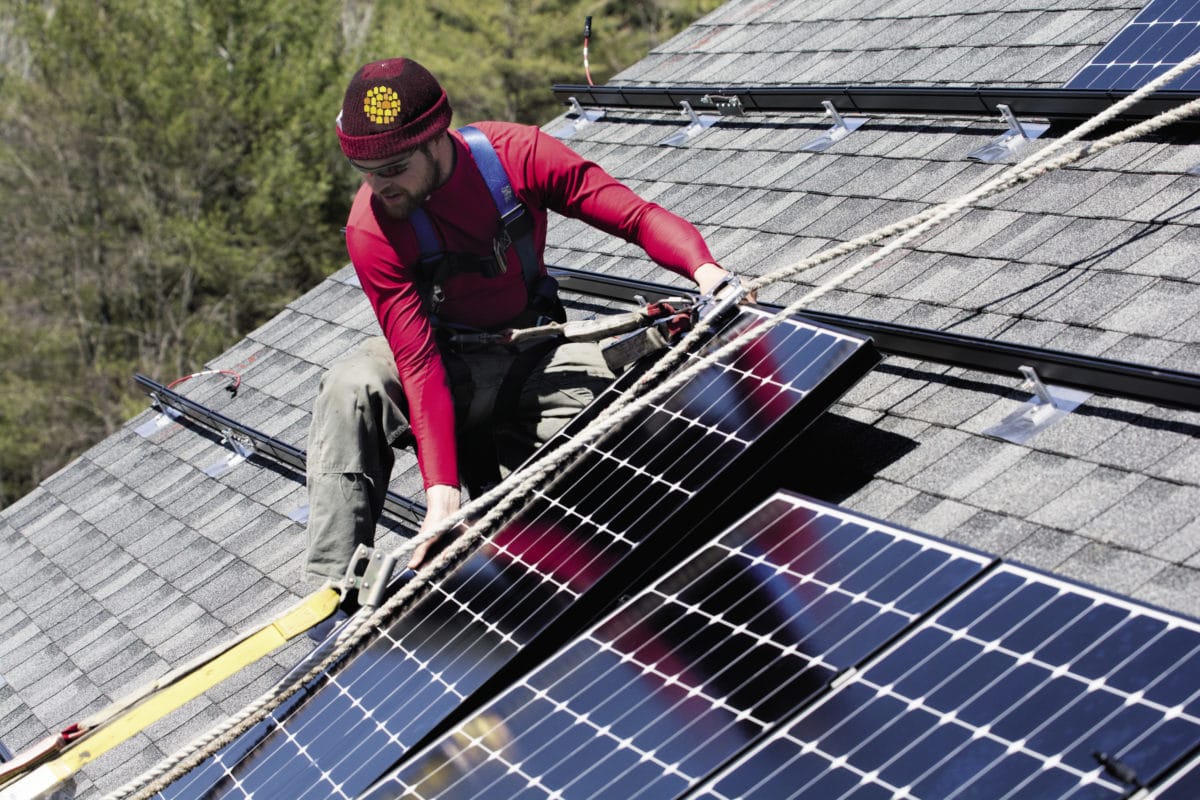California’s new residential solar mandate, effective from the first day of 2020, is going to add more than 1 GW of PV over the next five years, according to analysts. The state already has a nation-leading 26.2 GW cumulative PV installed base.
The new solar building code is directed at new housing construction up to three stories – mandating that single-family and multiple-family dwellings install enough solar to meet the home’s estimated annual electricity needs. Austin Perea, senior solar analyst at Wood Mackenzie Power and Renewables, said the mandate is not going to have an immediate impact – because building developers pulled permits in the previous year under the earlier building code.
But once it goes into effect, it will result in approximately 120 MW deployed in the back half of 2020, according to the analyst. SunPower, notes Perea, has already started its ramp-up.
Here are estimates for the costs and savings involved in new home solar, according to the California Energy Commission
- The new PV requirements will add about $8,400 to the cost of a single-family home.
- But the reduction in energy bills exceeds the increase in mortgage payments by around $35 per month (based on a conservative $3.10 per watt installed cost).
- The commission includes maintenance and inverter replacement costs in its life-cycle costing analysis.
- The commission assumed an average statewide residential retail rate of $0.18 per kWh to calculate the monthly energy bill savings of $80.
SunPower leads
To evaluate the likely impact of the new mandate, pv magazine spoke to SunPower CEO Tom Werner. He said that SunPower’s new homes group “struggled for eight or nine years, and several times we were considering getting out of the new homes business. It wasn’t scaling.”
But, according to the CEO, four or five years ago, home builder Lennar said, ‘We’re going 100% solar. Other home builders were not going 100%, but they were offering solar like any other feature in the home.’ “And then our solar new home business started to become real,” said Werner.
“In the new home business there are different criteria for winning. Of course, you need a good solution, you need the right price point. But you also need great execution. Execution is almost more important than the other factors because no one wants idle trades – it costs a lot of money and it will dominate the economics of the whole thing.”
Werner said that the key to SunPower’s positioning was working directly with new home builders. He estimates the Californian solar manufacturer has captured more than 50% market share with new solar builds in the state.
“We have 18 of the top 20 new home builders in California,” said Werner. “That scale and that experience of being completely integrated is a big barrier to entry. It’s not like you can come in and say, ‘We’ll give you a huge discount.’ because the builder says, ‘What’s your credibility on getting in and out? And by the way, that dwarfs the discount you’re willing to give me.’”
Werner added that for a home builder; “Working with a solar company such as SunPower means delivering ‘sustainable differentiation’ – and that this includes a battery storage component.” He also notes that “architects and planners will be thinking not only about integrating PV, but looking at how ‘storage and services’ can be integrated into their offering to homeowners.”
Exceptions to the rule
According to the California Energy Commission (CEC), “Exceptions to the PV requirement exist for specific instances in which a house may be built in an area of insufficient solar availability [shade] or where electricity rates are uncommonly low.” Buildings with especially small rooftops will be exempt.
Home builders can reduce the size of the solar installation by up to 40% by implementing grid-friendly battery storage, energy efficiency, and demand-response measures.
Building developers can build community solar projects instead of rooftop solar systems, with approval from the CEC and the local utility. But SunPower’s Werner noted that “the policy has some vague wording about what we would think of as community solar. A development could be built without solar as long as it had a community solar plant somewhere else.”
“But the somewhere else is important,” continued Werner. “We would say that somewhere else should be proximate to the new home. But if you’re a utility, you would say it needs to be somewhere in this universe.”
Following California’s lead
There is hope that if California succeeds in its new-build mandate, other states will introduce solar mandates in one form or another. “The new homes initiative is extremely exciting because as costs come down, other states will follow suit, because the downside is so low,” said Werner.
Massachusetts is considering a new home solar mandate, while other states and cities are mandating that buildings at least be “solar ready.”
As a result of the mandate, home solar installer Sunrun and its homebuilder partners deploy PV modules at the time of construction. As pv magazine USA has reported, attachments for the racking are installed below the roof shingles, directly to the plywood making up the roof. This will lower installation time, costs, and the risk of roof leaks.

Attachments for the racking system are built below the roof shingles, lowering installation costs and reducing the risk of roof leaks.
PV system prices could also drop because of lower installation costs – a recent study from the Department of Energy found that these are significantly higher in the United States ($3-5/W) than in Europe (€1.1-1.5/W). Customer acquisition costs, long the nemesis of the U.S. solar market, should also decline with the deployment of standard new home solar rooftops.
Abigail Hopper, head of the U.S. Solar Energy Industries Association, is particularly hopeful that the California mandate will help push PV into the mainstream for home builders. Hopper told Greentech Media, “I can’t overstate how strongly I feel about normalizing the solar experience, so it feels less risky to the consumer. There are 100,000 customers annually that will see the acquisition of solar as a normal part of their home transaction.”
This content is protected by copyright and may not be reused. If you want to cooperate with us and would like to reuse some of our content, please contact: editors@pv-magazine.com.








Not that I am in the market for a new home, but I really wish Colorado would mandate this. Especially in the metro areas. Even just mandating solar attach points when redoing a roof would go a long way. Colorado has a high rate of roof replacement due to the hail storms.
Interesting, in your experience there, does a roof with solar PV panels fare better in hail storms than roofs without solar PV panels?
I can partially answer your question on why Colorado doesn’t have a solar PV mandate on new construction. XCEL energy early on tried their best to “tax” solar PV home owners for having their own solar PV system and “using” the grid for their power “storage”, energy credit. Even the non solar PV ratepayers didn’t buy into this and so after some dog and pony show legerdemain, they dropped ‘that’ program and moved towards installing their own solar PV wind generation to insure XCEL owns the generation asset and takes up all of the RPS on the books now.
Yeah, I am pretty aware of Xcel’s history of fighting any kind of RE mandate….
Until pretty recently Colorado was a red state, then for a few years purple now blue with all three gov’t branches controlled by the Dems. In the coming election this will be cemented when we kick out the useless Republican senator. It is possible that we end up with a solar mandate for new builds in the next few years.
As far as hail on solar vs non-solar roofs the only data point I know of was the really devastating hail storm we had a few years ago when NREL reported 1 damaged solar panel out of 15,000 in their test setup. And the analysis showed that it had several softball sized strikes in the same spot.
Eric Wesoff, thank you for the numbers. In California they make “no brainer” sense when the three largest electric utilities in the State have some kind of tiered electricity rates, TOU rate spiking plans and then there’s still the push for getting rid of net metering and replacing it with net billing plans. California’s utilities have tried to “redeem” themselves with tiered electricity rates early on in the solar PV adoption in the State. It got to the point in SCE territory, tiered rates pushed the adoption of larger solar PV roofs in the 10kWp to 15kWp size as early as 2007. Homeowners were putting this sized system on their roofs and paying for the installation in 5 to 7 years of electricity savings.
I can tell you this from direct experience, some utilities are not IUOs and have “reasonable” electricity rates. But, they too are feeling the effects of the adoption of solar PV for home owners and the amount of power pushed back onto the grid during peak solar PV production of the day. I believe California was one of the very first who had enough solar PV and wind generation online around 2010, that “dumping” generated power became a “problem” and the “duck curve” was born. So, now almost all electric utilities are either implementing or considering TOU rate spiking to regain their “lost revenues” of the duck curve after solar PV rolls off in the late afternoon to early evening hours every day. In California the TOU and PSPS will push solar PV adopters to retrofit their current systems with smart energy storage or when a solar PV system is installed on one’s home, solar PV and energy storage will be the cohesive system package installed.